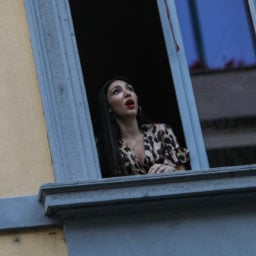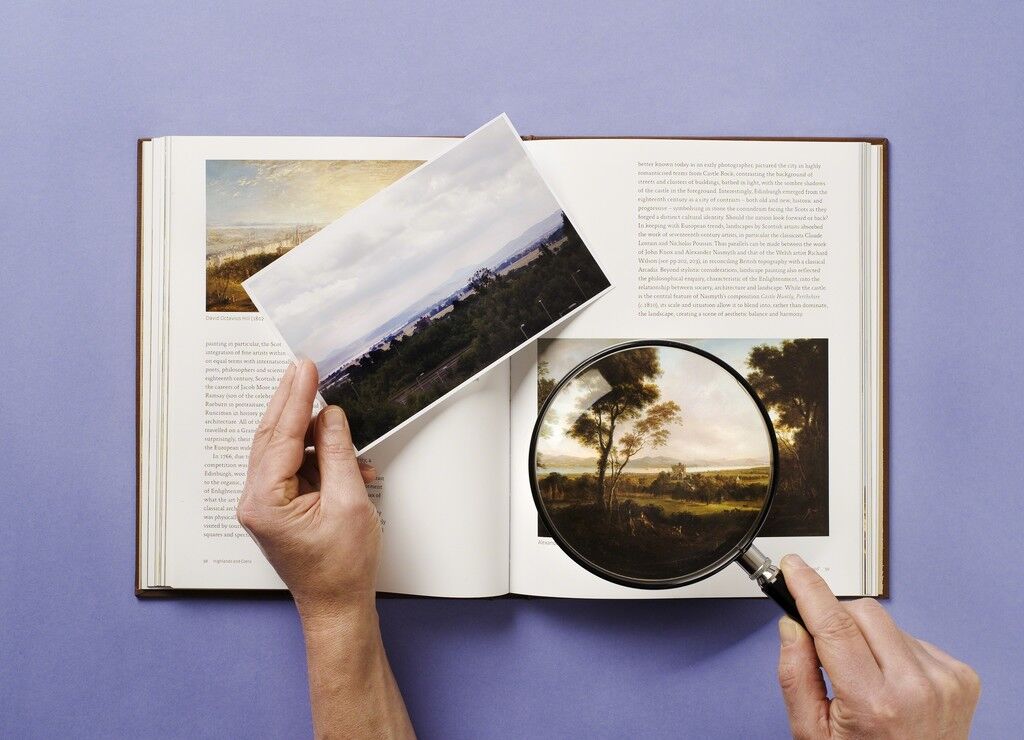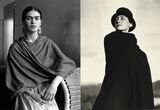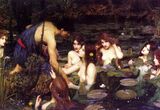Art World
Hungry to Learn Something New About Art? Here Are 14 of the Most Thrillingly Mind-Expanding YouTube Videos From Museums Around the Globe
Just because you can't walk into a museum right now, doesn't mean you can't get access to great arts and culture.

As we hunker down in our homes for the foreseeable future, we are becoming increasingly dependent on the internet for our cultural diets. Fortunately, YouTube has an extensive collection of videos from just about every museum you can think of—and many are hidden gems we might never have otherwise discovered.
From behind-the-scenes peeks at the world’s most prestigious collections to quirky interviews with top contemporary artists, you can connect with the art world from the comfort of your own home, just by pressing play.
We scoured the video service for the most delightful and informative videos, put out by museums for your viewing pleasure.
Recreating Ukiyo-e Hairstyles
From: The Art Institute of Chicago
Date posted: December 18, 2018
Length: 5:19
What It Is: Cultivating an ideal beauty—both in oneself and in art—was at the heart of Edo-era Japanese culture during the 17th to 19th centuries. Actors, geishas, and courtesans attempted to embody this perfect bijin (beauty) through a harmony of cosmetics, clothing, and hairstyle, which we see captured in Ukiyo-e paintings. In this video, watch as 90-year-old Minami Tomiko creates a series of the era’s intricate hairstyles, which are then presented alongside artworks with similar hairstyles in the museum’s collections.
Why It’s Worth Your Watch: Minami is one of the few remaining yūsoku hairstylists. Her grandmother opened a hair salon in Kyoto during the Meiji era (1868–1912), and there styled everyone from upper-class ladies to young dancers. Miami trained under her own mother for 30 years. Set only to music, the video is a hypnotizing glimpse of the past living in the present, in which we can better understand how fashion, cosmetics, theater, and art all interlocked to create the dazzling beauty of Japan’s “floating world.”
— Katie White
John Baldessari on René Magritte
From: Los Angeles County Museum of Art
Date posted: August 17, 2016
Length: 1:39
What It Is: A popular entry in the museum’s 25-video-strong “Artists on Art” series, this short piece sees the late beloved artist John Baldessari—a giant of the California art scene who died in January—spend some quality time with René Magritte’s The Treachery of Images. Better known as This is Not a Pipe, the painting is one of the most famous works in the museum collection.
Why It’s Worth Your Watch: The great conceptual artist marvels over how Magritte’s Surrealist masterpiece, painted two years before Baldessari was born, calls into question the very definition of art—a lifelong goal in his own practice. “I find it an incredibly intriguing painting because it has none of the earmarks of painting. There’s no brushmarks. It’s like a commercial artist has done it,” Baldessari says. “Saying this is not a pipe, the idea of denial, this is not what you think it is—I love that that’s a question that really intrigues me and informs a lot of my work… If I could do that in my own art, I would feel really accomplished. It would bring up a whole question about what art is.” Also, did you know that Baldessari had a collection of 50 pipes?
—Sarah Cascone
Behind the Scenes at the Cloisters
From: The Metropolitan Museum of Art
Date posted: July 10, 2010
Length: 11:28
What It Is: A tour of the Met’s most cloistered (I’m sorry) location, in Fort Tryon Park in New York. The Cloisters are an absolute gem: a shrine to medieval art built from a 12th-century French monastery that was taken apart and delivered, piece by piece, to the Inwood section of Manhattan. That story alone is remarkable. But on top of that, the museum is full of masterpieces. As Peter Barnet, the former curator in charge of the collection, says in this video, the Cloisters’ stunning works rival even the paintings and sculptures in the Met’s main building on Fifth Avenue.
Why It’s Worth Your Watch: If you’ve never been to the Cloisters, or if you have been and want to understand it more fully, there’s no better place to begin. Barnet, along with former Met director Thomas Campbell, provides an overview of how the museum was built, along with commentary on some of its greatest artworks, including the Unicorn Tapestries, the Merode Altarpiece, and the very cloister at the heart of the building.
—Pac Pobric
Ulay’s Pearls of Wisdom
From: Louisiana Channel, Denmark
Date posted: July 2017
Length: 2:57
What It Is: The performance artist Ulay, who died this year, gives some down-to-earth advice to younger artists who want to follow in his footsteps (or those of his former collaborator and partner Marina Abramovic). The short interview with Ulay is part of an ongoing strand with artists including Ed Ruscha, Ai Weiwei, and Candice Breitz, produced by the digital channel of the Louisiana Museum of Modern Art in Denmark.
Why It’s Worth Your Watch: If you want to really connect with an audience “then don’t kiss their asses,” Ulay warns. You have leave them wanting extra—around 30 percent more, to be exact—he advised. To find inspiration, don’t look for it in art school or go too often to museums and galleries where everything is readymade. He suggested instead: “Go behind Central Station” and find it in real life.
—Javier Pes
MoMA’s Reopening Magic
From: Museum of Modern Art
Date posted: September 20, 2019
Length: 7:11
What It Is: A fascinating in-depth look at the Herculean effort involved in the MoMA’s closure, renovation, and re-opening this past fall that resulted in a radical new re-hang done in less than a year’s time. As someone who attended the press preview day and was stunned at what I saw, it is impressive and fun to see both the monumental and minute details that went into this turnaround.
Why It’s Worth Your Watch: I love that this video series (and there are quite a few of these behind-the-scenes documentaries on MoMA’s YouTube channel) ranges from ironworkers hoisting and balancing multi-ton Richard Serra sculptures, to Betye Saar questioning the necessity of X-ray analysis of her newly re-hung works, to a security guard talking about keeping priceless artworks safe while standing in front of a massive Claude Monet mural. At a time when many of us are #WFH and looking for something to latch on to—and the museum is not open for at least the next several weeks—these videos are not only engrossing but will likely inspire viewers to run back to MoMA when as soon as we can.
—Eileen Kinsella
David Hockney on Vincent Van Gogh
From: The Van Gogh Museum
Date posted: March 4, 2019
Length: 8:11
What It Is: A delightful bit of extemporization from the art world’s favorite octogenarian, speaking on the occasion of his exhibition at the Van Gogh Museum in the Netherlands. Hockney has often spoke of finding inspiration in the swirling colors and inventive use of space that define Van Gogh’s painting, and this video shows him speaking about the artwork interspersed with archival footage of Hockney at work over the decades, and the places that inspired both artists.
Why It’s Worth Your Watch: Honestly, I’d watch David Hockney read assembly directions for an IKEA bookshelf, so imagine my delight at discovering a video of him narrating passages from Van Gogh’s own diaries in his lilting British accent, so clearly delighting in the words and images of an artist he so admired. Add to his charming voice the archival photographs that show up on screen of a floppy-haired younger Hockney at work in his studio, traipsing through the gardens of England, or sitting poolside in a (much too short) pair of swimtrunks, and I’m sold.
—Caroline Goldstein
How Nam June Paik Predicted the Future
From: Tate
Date posted: December 20, 2019
Length: 4:24
What It Is: A bite-size look at five ways that Nam June Paik, the late Korean-American artist who was the subject of an eye-opening retrospective at Tate that closed in February, predicted the future. Pouring over his writings, the narrator explains convincingly that Paik seems to have foreseen none other than: the internet, video art, the climate crisis, global media, and smartphones.
Why It’s Worth Your Watch: The cut-together clips of vintage ‘70s television shows, news broadcasts, and commercials that inspired much of Paik’s work is alone worth the price of admission (which happens to be free). But what will leave a lasting impression is the artist’s words. Way back in 1974, Paik predicted the creation of “electronic superhighways” that would enable “conferences between people in different locations via color video.” Although others had previously put forth the idea of a digital network, Paik was, according to Tate, the first person to propose that its primary purpose would be for communication. I’ve never been one to believe that all artists are automatically soothsayers who can see the future far more clearly than lay people, but, well, he really hit the nail on the head with that one, no?
—Julia Halperin
A Walking Tour of Edward Hopper’s New York
From: The Whitney Museum of American Art
Date posted: May 22, 2013
Length: 5:01
What It Is: Here, Carter Foster—then the curator of drawings at the Whitney and now deputy director of the Blanton Museum at the University of Texas—takes viewers on a jaunt through the West Village, stopping to comment on the street corners and lunch counters frequented by Edward Hopper, including his walk-up studio—74 steps!—and the various storefront facades that inspired his famous painting Nighthawks.
Why It’s Worth Your Watch: Foster is a charming, informative walking-tour host, and the brilliant edit lets the real buildings in the Village crossfade into the Hopper paintings, quite viscerally bringing the masterpieces to life. And seeing the bustling shops and restaurants along Greenwich Avenue teeming with happy, healthy New Yorkers is actually a healing balm if you’re exiled out of the city or trapped in your apartment for the foreseeable future.
—Nate Freeman
Jane’s Addiction
From: Rijksmuseum
Date posted: August 14, 2019
Length: 3:24
What It Is: The head of the print room at the Rijksmuseum, Jane Turner, has her own mini series amusingly titled “Jane’s Addiction” in which she shares interesting tidbits that her research turns up about works on paper, prints, and drawings in the collection.
Why It’s Worth Your Watch: In this video, Turner investigates a funny-looking plant recorded in a collection of 750 watercolors commissioned by Emperor Rudolph II of Prague. The emperor asked his private physician, Anselmus de Boodt, to record the natural history world around him, including animals, birds, and flowers. The physician also sneaked some mythical creations into the pack, including a dragon and a weird hybrid fish-horse thing. When Turner came across a plant with little skulls on its leaves she assumed it was one of these fantastical creations, but on further research discovered that it is actually a snapdragon plant, and the seed pods of which look just like mini skulls. Who says botany has to be dull?
—Naomi Rea
Lucian Freud on His Last Day of Painting
From: Kunsthistorisches Museum, Vienna
Date posted: October 2013
Length: 3:05
What It Is: The world-famous British painter, who died in 2011, was captured on camera painting his last work three months before he died. Ahead of its posthumous show on the painter, in 2013, the Kunsthistorisches Museum shared this candid footage.
Why It’s Worth Your Watch: It is a rare thing to see great artists at work. There is something even more special about this video because it is filmed by Freud’s dear friend, assistant, and frequent portrait sitter David Dawson, who poses on the ground for Freud’s last painting. Freud seems totally at ease and unconcerned with the camera Dawson is holding, and the short video is permeated by many comfortable and concentrated pauses while Freud works away in his paint-splattered studio.
—Kate Brown
Fred Wilson’s Museum Interventions
From: San Francisco Museum of Modern Art
Date posted: June 3, 2019
Length: 3:06
What It Is: In an excerpt from a 2015 interview and studio visit, multidisciplinary artist Fred Wilson succinctly tells us how and why, in the 1990s, he began re-installing institutions’ own collections in a way that brought their hidden biases into plain (if jarring) view.
Why It’s Worth Your Watch: What makes SFMOMA’s video series special is the way it elevates the blue-flame thinking of great artists with dynamic filmmaking and editing. In general, the museum breaks in-depth interviews into bite-sized, thematic segments each posted as individual videos rather than sprawling odysseys. Here, Wilson dissects one of the museum sector’s central issues in the same run time as a pop song, while SFMOMA’s team complements the interview with a pitch-perfect musical score and both stills and video of some of the interventions in question—including when Wilson inserted a whipping post into a gallery celebrating fine 19th-century American furniture.
—Tim Schneider
Building a James Turrell Installation
From: The Guggenheim Museum
Date posted: December 8, 2016
Length: 4:42
What It Is: Exhibition designers and production specialists at the Guggenheim reveal how they installed James Turrell’s Aten Reign, turning the museum’s iconic rotunda into an immersive skyscape for the artist’s 2013 retrospective.
Why It’s Worth Your Watch: For those who walk into an exhibition and wonder not how the art was made but how it was installed, the Guggenheim’s channel is for you. The museum—an architectural marvel but a challenging place to show art—takes you behind the scenes into how its most ambitious rotunda installations were assembled, from the network of criss-crossing tubes that made up Motonaga Sadamasa’s Work (Water) in the 2013 exhibition “Gutai: Splendid Playground,” to Maurizio Cattelan’s 2012 show “All,” in which all of the artist’s works were suspended from the ceiling. But Turrell’s immersive installation gets the vote here because of the design ingenuity that so perfectly united Turrell’s vision with Frank Lloyd Wright’s.
—Taylor Dafoe
Kerry James Marshall on the Meaning of Process
From: Los Angeles Museum of Contemporary Art
Date posted: March 31, 2017
Length: 2:56
What It Is: The museum’s “Process” video series visits artists in their studios and interviews them about how they make their work. In this installment, Kerry James Marshall gives a peek inside his Chicago studio on the occasion of his traveling 2017 retrospective “Mastry.”
Why It’s Worth Your Watch: Some discussions of process can be dry and technical. But Marshall lucidly explains how, for him, process consists of both making physical paintings and of reimagining the paradigm of what painting can be. “You can orient your actions so you can get into the institutions that are already established or you can orient your actions so that you establish a new place that sits alongside it,” he says in the video. For Marshall, both were necessary: “Yes, I like this museum, but I want to be in this museum too.”
—Rachel Corbett
Learn to Paint Like Yayoi Kusama
From: Museum of Modern Art
Date posted: March 22, 2017
Length: 20:07
What It Is: This, the most popular episode of MoMA’s YouTube “In the Studio” series with three million views, has host Corey D’Augustine, a painter and conservator, demonstrating the ins and outs of creating a composition like Yayoi Kusama, the Japanese painter these days best known for her mirrored rooms.
Why It’s Worth Your Watch: Because D’Augustine conjures the painting in front of your eyes, you really get a pretty magical sense of how Kusama’s all-over compositions are made, and what kind of effort goes into them.
—Nan Stewart
Follow artnet News on Facebook:
Want to stay ahead of the art world? Subscribe to our newsletter to get the breaking news, eye-opening interviews, and incisive critical takes that drive the conversation forward.

It looks like you're using an ad blocker, which may make our news articles disappear from your browser.
artnet News relies on advertising revenue, so please disable your ad blocker or whitelist our site.
To do so, simply click the Ad Block icon, usually located on the upper-right corner of your browser. Follow the prompts from there.
SHARE








